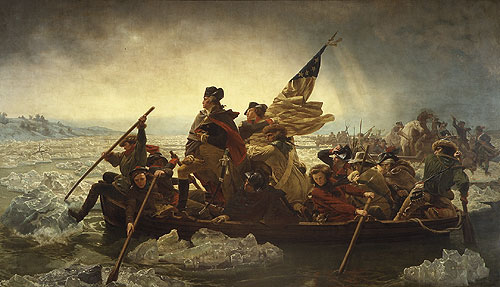A Small-Scale Amphibious Operation Helped Save the Day for the Continental Army
During Christmas week, 1776, the survival of the Continental Army and future course of the American Revolution were in serious doubt. General George Washington, Commander-in-Chief, lay encamped on the western shore of the Delaware River, having lost control of New York City and retreating across New Jersey. His roughly 6,000-man Army was scattered along an 80-mile line. The possibility of an enemy attack from across the river seemed real. Worse still, nearly three-fourths of the Army was scheduled to go home when the troops’ commissions expired at the end of the year.
A bold step was required, and Washington resolved to take it. His goal was Trenton, New Jersey, one of several outposts the British had established to keep control of northern New Jersey. A garrison of Hessian mercenaries held the town. They expected a quiet winter. Some even thought it might be the last of the Revolutionary War.
Washington planned to take personal command of the main force of about 2,400 men in a three-pronged attack once they had crossed the Delaware River. Once they reached Trenton, he would then push east and take Princeton and New Brunswick.
 |
| Col. John Glover |
Hoping to surprise the Hessian garrison in the midst of holiday celebrations, Washington selected Christmas Day for the operation. To transport his men, horses, and artillery, he selected Durham boats. They were forty to sixty feet long, eight feet wide, and approximately two feet deep, pointed at both ends like a canoe, and capable of transporting cargo.
Responsibility for manning the vessels fell to Col. John Glover’s regiment (the 14th Continental) comprised of nearly one thousand fishermen and sailors from Marblehead, Massachusetts, dressed in the blue jackets, white caps, and tarred trousers typical of their trades. The regiment already enjoyed a solid reputation, having safely conducted Washington’s troops in retreat from Long Island the previous August. These hearty New Englanders were the amphibious engineers of their day, as skilled with oars and sail as guns.
Conditions that night turned frightful. Temperatures hovered below freezing, floating ice filled the river, and in the midst of the operation a storm brought wind-driven rain, hail, and blinding snow. Delays meant that the bulk of the maneuver occurred after dark and, worse, that the attack on Trenton would take place in daylight.
Not surprisingly, two divisions were unable to reach the Delaware shoreline. Unaccustomed as they were to handling the Durham boats, by three o’clock that morning, the men of Glover’s 14th successfully maneuvered Washington and one division of men and artillery across to the eastern shore without loss of life or artillery. From there the troops were in position to march on Trenton. By eight o’clock that morning, 26 December, shooting began at Trenton. Within the hour the surprised Hessians had surrendered.

| This oil painting of George Washington crossing the Delaware is filled with inaccuracies, ". . . but if this painting has served no other purpose," according to one historian, "it has immortalized the performace of Glover's regiment . . . the seafaring talents of Glover's unit gave it the worth of ten regiments that night." |
Image courtesy of: www.metmuseum.org
Emanuel Gottlieb Leutze, American, 1816-1868
George Washington Crossing the Delaware, 1851
Oil on Canvas; 12 2/5 x 21 1/4 in. (378.5 x 647.7 cm)
Gift of John S. Kennedy, 1897 (97.34)
* * *
December 2002